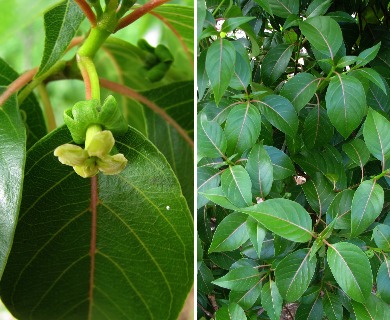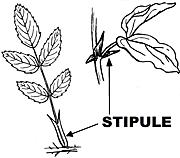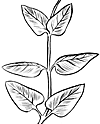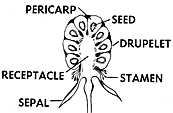'Ahakea
Bobea sandwicensis
Madder family (Rubiaceae)
Native species ()
The Bobea, common name ‘ahakea, is known only from the Hawaiian Islands and has 4 or fewer species of trees distributed through the islands. They have small paired pale green leaves with paired small pointed that shed early, 1–7 small flowers at leaf bases, with tubular greenish the four overlapping in bud, and small round black or purplish (), mostly dry, with 2–6 nutlets. This species, described below, will serve as an example.

©2009 David Eickhoff
Leaves with pinkish finely hairy leaf-stalks of 3⁄8–5⁄8 inch (1 –1. 5 ) and paired small pointed hairy 1⁄8 inch (3 ) long that form a bud and shed early. Blades are or elliptical, 2–3 1⁄2 inches (5–9 ) long and 1–2 inches (2.5–5 ) wide, short- to long-pointed at and blunt at base, with edges straight or slightly wavy, thin. Upper surface slightly shiny green, hairless, with pinkish and few curved side veins; lower surface light green with pinkish raised and tiny hairs in vein angles.
Flowers mostly 1–3 at leaf bases on slender stalks of 1⁄4–1 inch (6–25 ), 5⁄16 inch (8 ) long, finely hairy, composed of greenish base () 1⁄8 inch (3 ) long; of 4 spreading elliptical green to 3⁄16 inch (5 ) long; whitish green 1⁄4 inch (6 ) long with narrow cylindrical tube and four spreading narrow overlapping in bud; four stalkless in notches of and with inferior short and 4–6-
() round, about 3⁄8 inch (1 ) in diameter, purplish black and slightly shiny, with tiny pressed hairs, with 4 enlarged rounded more than 1⁄4 inch (6 ) long remaining at containing 2–6 stones (nutlets), each 1-seeded.
Wood yellow, hard and heavy, straight-grained. Used by the Hawaiians for the carved end covers and gunwales of canoes for its yellow appearance and for its wearability. Modern canoes are often painted yellow at the gunwales to simulate ‘ahakea wood. Also used for poi boards and paddles.
Scattered in wet to dry forests and on open lava flows at 300–4000 ft (105–1220 ) elevation.
Range
Maui, Lanai, Molokai, and Oahu
Botanical
Bobea hookeri Hillebr.
This was named in 1830 for Bobe-Moreau, physician and pharmacist in the French Marine. Three other species are found on the large islands of Hawaii.










